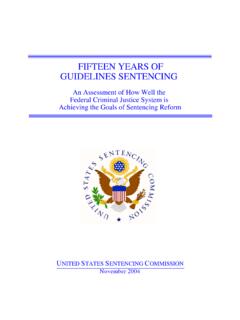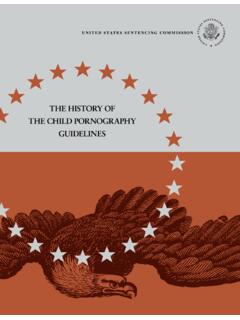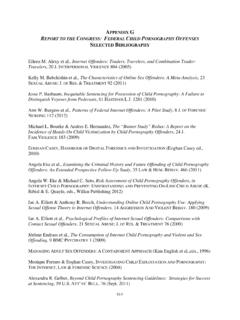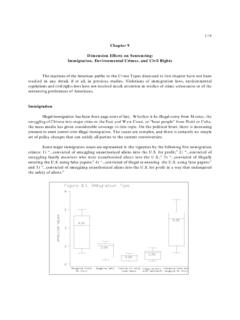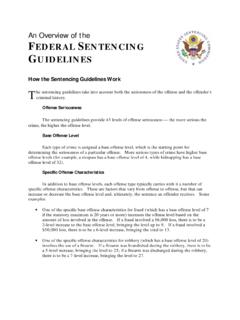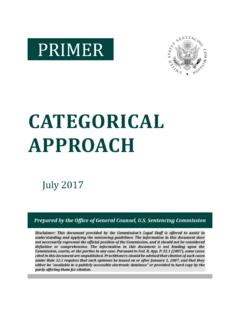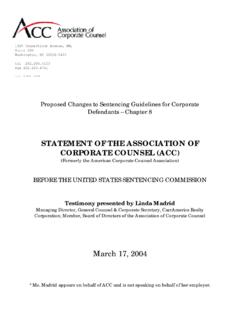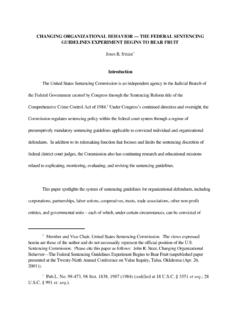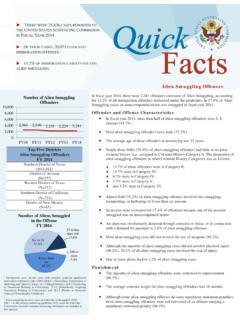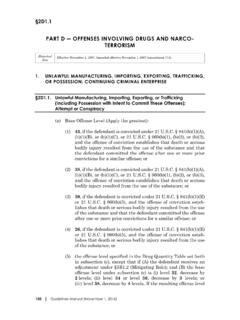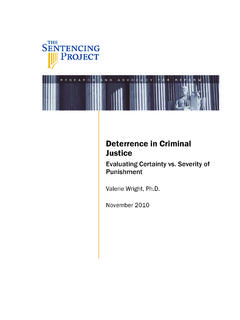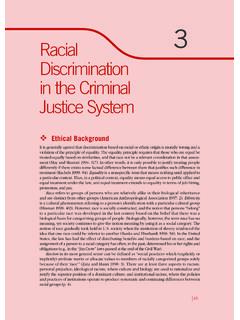Transcription of Alternatives to Sentencing in the Federal Criminal Justice ...
1 Alternative Sentencing in the Federal Criminal Justice System UNITED STATES Sentencing COMMISSION United States Sentencing Commission One Columbus Circle, Washington, DC 20002 Patti B. Saris Chair Charles R. Breyer Vice Chair Dabney L. Friedrich Commissioner Rachel E. Barkow Commissioner William H. Pryor, Jr. Commissioner Jonathan J. Wroblewski Ex Officio Kenneth P. Cohen Staff Director Glenn R. Schmitt Director Office of Research and Data Louis Reedt Deputy Director Office of Research and Data May 2015 Introduction In January 2009 the United States Sentencing Commission issued a report , Alternative Sentencing in the Federal Criminal Justice System.
2 The report analyzed data from the prior decade concerning the imposition of alternative sentences by Federal In particular, that report found the proportion of Federal offenders sentenced to Alternatives .. remained low and decreased slightly during the prior As a supplement to the 2009 publication, the Commission is releasing this new report , using data from 2005 through 2014, to examine more recent trends in the rates of alternative sentences using a methodology that expands that of the prior report . Notably, this new report updates the previous analysis to include Federal Sentencing data since the Supreme Court s December 2007 decision in Gall v.
3 United States,3 which reinforced Sentencing courts discretion to vary below the Sentencing ranges recommended by the Guidelines This current report examines how Sentencing courts use their discretion to impose alternative sentences, specifically combinations of probation and confinement options that substitute for the full prison terms permitted by law. This analysis shows a continued decreasing trend in the imposition of alternative sentences and explores factors associated with the decrease. In examining these trends, this report demonstrates: Alternative sentences were imposed for a small proportion of Federal offenders, in part, as a result of the large number of Federal offenders who were ineligible for such sentences due to convictions under certain statutes or their status as deportable aliens.
4 During the past ten years, rates of alternative sentences declined among citizen Federal offenders who were eligible for such sentences despite 1) a steady overall increase in sentences below the guideline range due to downward departures or variances and 2) overall consistency in offense severity and Criminal history among those offenders. In recent years, the decrease in rates of alternative sentences for eligible offenders, in part, is a reflection of the Commission's 2010 amendment that expanded Zones B and C of the Sentencing Table.
5 The amendment added to Zones B and C offenders whose Sentencing ranges previously were in Zones C and D, thereby increasing the proportion of offenders eligible for Alternatives . However, as to be expected, courts imposed Alternatives for these more serious offenders less frequently than for offenders whose Alternative Sentencing in the Federal Criminal Justice SystemCourtney R. Semisch, Senior Research Associate Office of Research and Data United States Sentencing Commission 2 Sentencing ranges otherwise were in Zones B and C. This has contributed to the decrease in the rate of alternative sentences for eligible offenders.
6 Alternative sentences were imposed at notably different rates for offenders in different race categories with White offenders receiving such sentences at higher rates than Black and Hispanic offenders. During the past ten years, alternative sentences have been imposed at a consistently low rate among citizen offenders whose Sentencing ranges were in Zone D of the Sentencing Table. Background The Sentencing Reform Act of 1984 (the Act )5 envisioned sentences other than imprisonment as generally appropriate[] .. in cases in which the defendant is a first offender who has not been convicted of a crime of violence or an otherwise serious offense.
7 6 The Act established probation as a stand-alone Sentencing option, rather than as an instrument used in suspending prison Alternative Sentencing options were further expanded by the Anti-Drug Abuse Amendment Act of 1988,8 which authorized the use of home detention and electronic monitoring for offenders sentenced to probation and those serving terms of supervised The Commission incorporated these policies into the Federal Sentencing guidelines along with other probation and intermediate confinement options for less serious and first-time Sentencing Table and Zones The guidelines Sentencing Table (see Guidelines Manual, Chapter Five, Part A)
8 Provides Sentencing ranges based on an offender s final offense level and Criminal History The table is subdivided into four zones (A, B, C, and D) that determine confinement options for each Sentencing The four options, in increasing order of severity, are: Probation-only (zero months of confinement); Probation that includes a condition or combination of conditions that substitute intermittent confinement, community confinement, or home detention for imprisonment; Imprisonment followed by a term of supervised release with a condition or combination of conditions that substitute community confinement or home detention (split sentence); and Prison-only.
9 Sentencing ranges in Zone A are from zero to six months of confinement. At the Sentencing court s discretion, the zero-to-six month range may consist of probation-only, probation with a confinement condition, a split sentence, or imprisonment. Sentencing ranges in Zone B include confinement terms ranging from one to 15 months. The guidelines advise that Zone B allows probation terms to be substituted for imprisonment, provided that the probation term includes confinement conditions (community confinement, Alternative Sentencing in the Federal Criminal Justice System 3 intermittent confinement, or home detention).
10 13 For offenders whose Sentencing ranges fall into Zone B and who are sentenced to prison, the guidelines provide that a minimum of one month of the total term imposed must be imprisonment. The remainder of the sentence also may be imprisonment or a substitution of probation that includes community confinement or home detention. Any sentence for offenders whose Sentencing ranges fall into Zone B and who are sentenced to probation (without any term of confinement) necessarily constitutes either a downward departure or Sentencing ranges in Zone C of the Sentencing Table include confinement terms ranging from ten to 18 months.
